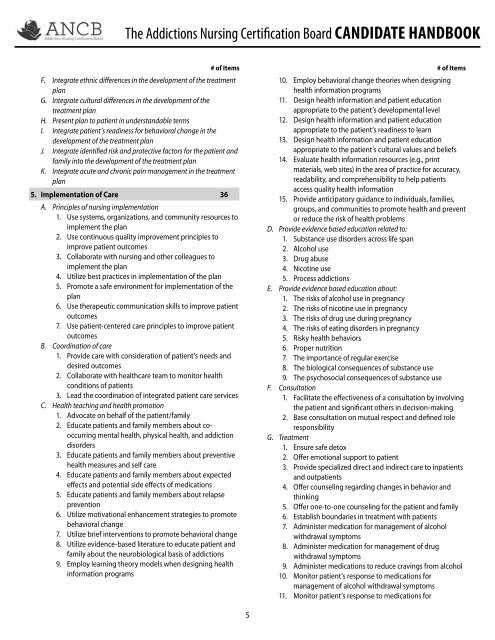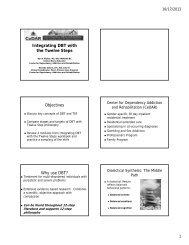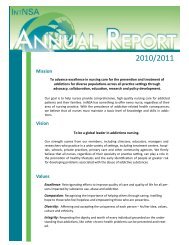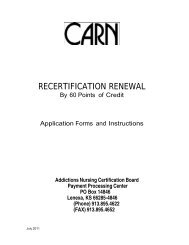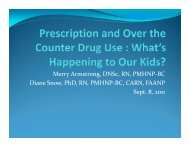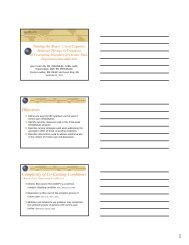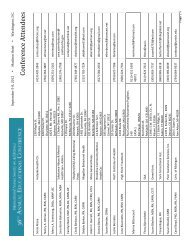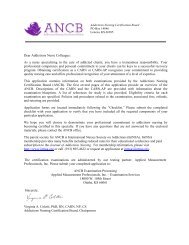candidate handbook - International Nurses Society on Addictions
candidate handbook - International Nurses Society on Addictions
candidate handbook - International Nurses Society on Addictions
You also want an ePaper? Increase the reach of your titles
YUMPU automatically turns print PDFs into web optimized ePapers that Google loves.
The Addicti<strong>on</strong>s Nursing Certificati<strong>on</strong> Board Candidate HandbookF. Integrate ethnic differences in the development of the treatmentplanG. Integrate cultural differences in the development of thetreatment planH. Present plan to patient in understandable termsI. Integrate patient’s readiness for behavioral change in thedevelopment of the treatment planJ. Integrate identified risk and protective factors for the patient andfamily into the development of the treatment planK. Integrate acute and chr<strong>on</strong>ic pain management in the treatmentplan5. Implementati<strong>on</strong> of Care 36A. Principles of nursing implementati<strong>on</strong>1. Use systems, organizati<strong>on</strong>s, and community resources toimplement the plan2. Use c<strong>on</strong>tinuous quality improvement principles toimprove patient outcomes3. Collaborate with nursing and other colleagues toimplement the plan4. Utilize best practices in implementati<strong>on</strong> of the plan5. Promote a safe envir<strong>on</strong>ment for implementati<strong>on</strong> of theplan6. Use therapeutic communicati<strong>on</strong> skills to improve patientoutcomes7. Use patient-centered care principles to improve patientoutcomesB. Coordinati<strong>on</strong> of care1. Provide care with c<strong>on</strong>siderati<strong>on</strong> of patient’s needs anddesired outcomes2. Collaborate with healthcare team to m<strong>on</strong>itor healthc<strong>on</strong>diti<strong>on</strong>s of patients3. Lead the coordinati<strong>on</strong> of integrated patient care servicesC. Health teaching and health promoti<strong>on</strong>1. Advocate <strong>on</strong> behalf of the patient/family2. Educate patients and family members about cooccurringmental health, physical health, and addicti<strong>on</strong>disorders3. Educate patients and family members about preventivehealth measures and self care4. Educate patients and family members about expectedeffects and potential side effects of medicati<strong>on</strong>s5. Educate patients and family members about relapsepreventi<strong>on</strong>6. Utilize motivati<strong>on</strong>al enhancement strategies to promotebehavioral change7. Utilize brief interventi<strong>on</strong>s to promote behavioral change8. Utilize evidence-based literature to educate patient andfamily about the neurobiological basis of addicti<strong>on</strong>s9. Employ learning theory models when designing healthinformati<strong>on</strong> programs# of Items # of Items510. Employ behavioral change theories when designinghealth informati<strong>on</strong> programs11. Design health informati<strong>on</strong> and patient educati<strong>on</strong>appropriate to the patient’s developmental level12. Design health informati<strong>on</strong> and patient educati<strong>on</strong>appropriate to the patient’s readiness to learn13. Design health informati<strong>on</strong> and patient educati<strong>on</strong>appropriate to the patient’s cultural values and beliefs14. Evaluate health informati<strong>on</strong> resources (e.g., printmaterials, web sites) in the area of practice for accuracy,readability, and comprehensibility to help patientsaccess quality health informati<strong>on</strong>15. Provide anticipatory guidance to individuals, families,groups, and communities to promote health and preventor reduce the risk of health problemsD. Provide evidence based educati<strong>on</strong> related to:1. Substance use disorders across life span2. Alcohol use3. Drug abuse4. Nicotine use5. Process addicti<strong>on</strong>sE. Provide evidence based educati<strong>on</strong> about:1. The risks of alcohol use in pregnancy2. The risks of nicotine use in pregnancy3. The risks of drug use during pregnancy4. The risks of eating disorders in pregnancy5. Risky health behaviors6. Proper nutriti<strong>on</strong>7. The importance of regular exercise8. The biological c<strong>on</strong>sequences of substance use9. The psychosocial c<strong>on</strong>sequences of substance useF. C<strong>on</strong>sultati<strong>on</strong>1. Facilitate the effectiveness of a c<strong>on</strong>sultati<strong>on</strong> by involvingthe patient and significant others in decisi<strong>on</strong>-making2. Base c<strong>on</strong>sultati<strong>on</strong> <strong>on</strong> mutual respect and defined roleresp<strong>on</strong>sibilityG. Treatment1. Ensure safe detox2. Offer emoti<strong>on</strong>al support to patient3. Provide specialized direct and indirect care to inpatientsand outpatients4. Offer counseling regarding changes in behavior andthinking5. Offer <strong>on</strong>e-to-<strong>on</strong>e counseling for the patient and family6. Establish boundaries in treatment with patients7. Administer medicati<strong>on</strong> for management of alcoholwithdrawal symptoms8. Administer medicati<strong>on</strong> for management of drugwithdrawal symptoms9. Administer medicati<strong>on</strong>s to reduce cravings from alcohol10. M<strong>on</strong>itor patient’s resp<strong>on</strong>se to medicati<strong>on</strong>s formanagement of alcohol withdrawal symptoms11. M<strong>on</strong>itor patient’s resp<strong>on</strong>se to medicati<strong>on</strong>s for


